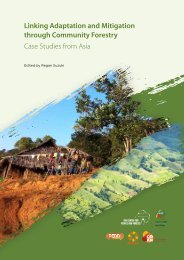Desktop Study on - Regional Climate Change Adaptation ...
Desktop Study on - Regional Climate Change Adaptation ...
Desktop Study on - Regional Climate Change Adaptation ...
You also want an ePaper? Increase the reach of your titles
YUMPU automatically turns print PDFs into web optimized ePapers that Google loves.
Assessment of Capacity Gaps and Needs of South East Asia Countries<br />
in Addressing Impacts, Vulnerability and Adaptati<strong>on</strong> to <strong>Climate</strong> Variability and <strong>Climate</strong> <strong>Change</strong><br />
RESEARCH SYNTHESIS ON THAILAND<br />
COUNTRY<br />
CHARACTERISTICS<br />
The country characteristics cover informati<strong>on</strong><br />
<strong>on</strong> Thailand’s geographical, social, ec<strong>on</strong>omic<br />
and climatic risks. An overview of the country’s<br />
characteristics is provided in Table 10.<br />
Geographic Situati<strong>on</strong><br />
Thailand is located in the Mek<strong>on</strong>g Regi<strong>on</strong>, bordering<br />
<strong>on</strong> Myanmar in the Northwest (1,800 kilometres),<br />
Laos in the Northeast (1,754 kilometres), Cambodia<br />
in the East (803 kilometres), and Malaysia in the South<br />
(506 kilometres). From its total land area of about<br />
513120 km2, approximately 20% are mountainous,<br />
located mainly in the north al<strong>on</strong>g the borders with<br />
Myanmar and Laos and extending down the Isthmus<br />
of Kra to the southern border with Malaysia. The<br />
central plain, which extends to the Gulf of Thailand,<br />
is a lowland area drained by the Chao Phraya and its<br />
tributary rivers. The narrow and tropical Isthmus of<br />
Kra runs from mainland Thailand to the border with<br />
Malaysia and has a low-lying range of hills at the<br />
narrowest part, about 600 meters in elevati<strong>on</strong> (FRD,<br />
2007).<br />
Socio-Ec<strong>on</strong>omic Status<br />
According to the 2006 census, the populati<strong>on</strong> of<br />
Thailand is 64.4 milli<strong>on</strong> inhabitants (reaching the<br />
nineteenth positi<strong>on</strong> am<strong>on</strong>g the most populous<br />
countries in the world), resulting with 125 people<br />
per km2 (FRD, 2007). The populati<strong>on</strong> growth rate<br />
was about 20.7% and some estimates made in<br />
Table_10 Thailand country profile<br />
overview<br />
Country level informati<strong>on</strong> (UN data, 2009; FRD, 2007)<br />
Surface area (km2) 513,120<br />
Bordering countries<br />
Populati<strong>on</strong> density, 2007 (pers<strong>on</strong>s/<br />
km2)<br />
Populati<strong>on</strong> growth rate, 2005-2010 (%<br />
per annum)<br />
Malaysia,<br />
Myanmar,<br />
Lao PDR, and<br />
Cambodia<br />
124.5<br />
0.7<br />
Mountainous land (% of total area) 20<br />
Flat land (% of total area) 80<br />
C<strong>on</strong>tributi<strong>on</strong> of agricultural sector to<br />
GDP, 2008 (%)<br />
C<strong>on</strong>tributi<strong>on</strong> of industrial sector to<br />
GDP, 2008 (%)<br />
C<strong>on</strong>tributi<strong>on</strong> of service sector to GDP,<br />
2008 (%)<br />
Percentage of populati<strong>on</strong>, 2007 (%) in<br />
- rural areas<br />
- urban areas<br />
Poor populati<strong>on</strong>, 2004 (% of<br />
households)<br />
Infant mortality rate, 2005-2010 (per 1<br />
000 live births)<br />
Adult literacy rate, 2007 (% of total<br />
populati<strong>on</strong>, estimate)<br />
11.4<br />
44.5<br />
44.1<br />
67.1<br />
32.9<br />
10<br />
11.0<br />
92.6<br />
Agricultural land (% of total area in<br />
2005)<br />
27.5<br />
Access to water supply, 2007 (% of<br />
total populati<strong>on</strong>, estimate)<br />
85<br />
GDP, 2007 (milli<strong>on</strong> current USD) 245351<br />
87

















